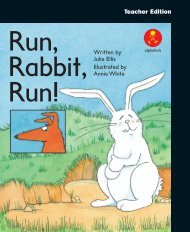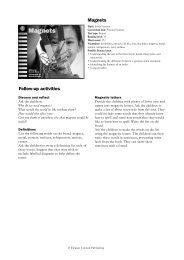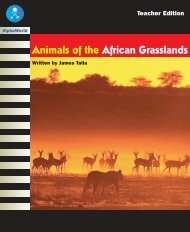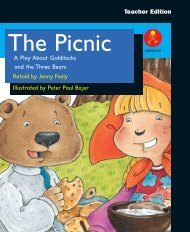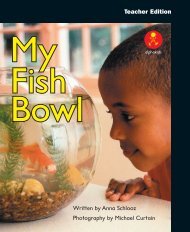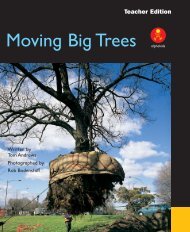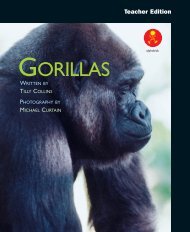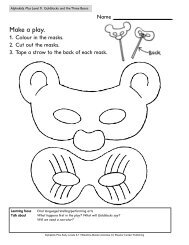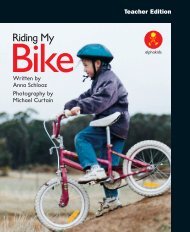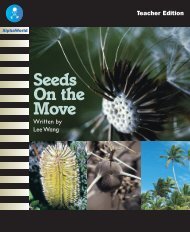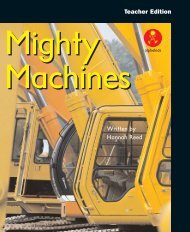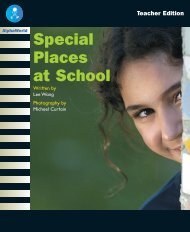My Farm
My Farm
My Farm
You also want an ePaper? Increase the reach of your titles
YUMPU automatically turns print PDFs into web optimized ePapers that Google loves.
Teacher Edition<br />
<strong>My</strong> <strong>Farm</strong><br />
alphakids<br />
Written by Jack Hastings<br />
Photography by Michael Curtain
Published edition<br />
© Eleanor Curtain<br />
Publishing 2004<br />
First published 2004<br />
Apart from any fair dealing for<br />
the purposes of study, research,<br />
criticism or review, as<br />
permitted under the Copyright<br />
Act of Australia, no part of this<br />
book may be reproduced by<br />
any process, or transmitted in<br />
any form, without permission<br />
of the copyright owner. Where<br />
copies of part or the whole of<br />
this book are made under Part<br />
VB of the Copyright Act, the<br />
law requires that records of<br />
such copying be kept and the<br />
copyright owner is entitled to<br />
claim payment.<br />
Developed by<br />
Eleanor Curtain Publishing<br />
Text: Kerrie Shanahan<br />
Consultant: Susan Hill<br />
Designed by<br />
Alexander Stitt<br />
Production by<br />
Publishing Solutions<br />
Printed in China<br />
ISBN 0 7253 3385 5<br />
1 2 3 4 5 6 7 8 9<br />
04 05 06<br />
?<br />
How to use this book<br />
Before reading: Talkthrough<br />
Talk through the book with the children. Encourage<br />
them to predict the text from the cover and the<br />
pictures, and to think about the information they<br />
provide. Direct the children’s attention to aspects of<br />
the text that may challenge them. Support the children<br />
to deal with these challenges by asking the<br />
Talkthrough questions on each page.<br />
During reading: Observe and support<br />
Observe the children as they read. Encourage them<br />
to monitor their own reading as they comprehend<br />
the text. As needed, support the children by helping<br />
them to discover and use reading strategies and cues<br />
to solve problems and respond to reading challenges<br />
that arise in the text. Interruptions to the children’s<br />
reading should be minimal and focused on specified<br />
learning needs.<br />
After reading: Comprehension, returning to<br />
the text, responding and writing links<br />
To further develop children’s understanding of the<br />
text, select from activities found on page 16 and the<br />
inside back cover. These whole text, sentence and word<br />
level activities reinforce the teaching focus of this<br />
book. Assessment ideas are provided to assist with<br />
planning for further teaching.<br />
Text highlights<br />
• The text has a predictable structure.<br />
• The text is supported and extended by<br />
colour photographs.<br />
Vocabulary<br />
animals, cows, eggs, farm, fruit, hens, honey,<br />
milk, plants, sheep, wool, vegetables
Setting the context<br />
Have you been to a farm? What did you<br />
see? Why do we have farms?<br />
Introducing the book<br />
This is a factual text about a farm. It tells us<br />
about the animals and plants found on the<br />
farm and what we get from them.<br />
Front cover<br />
Talk about the photograph on the front cover.<br />
What things might you see on this farm?<br />
What makes you think this?<br />
Title page<br />
Point out the title, and the names of the<br />
author and photographer.<br />
Look at the picture. Who do you think the<br />
boy might be?
<strong>My</strong> <strong>Farm</strong> Pages 2–3<br />
?<br />
Talkthrough<br />
This is the first page of the book and it tells us what sort of<br />
information will be in the rest of the book. What animals do<br />
you think will be in the book? What other information might<br />
it contain?<br />
Observe and support<br />
Can the children understand the information they<br />
have read?<br />
Where does the boy live? What does he have on his farm?<br />
2
<strong>My</strong> <strong>Farm</strong> Pages 4–5<br />
?<br />
Talkthrough<br />
Do you like milk? Do you think this boy likes milk? How can<br />
you tell?<br />
Observe and support<br />
Do the children use visual information to support their<br />
reading?<br />
I like the way you looked at the picture to help work out that<br />
word. What is the boy doing in the picture?<br />
4
<strong>My</strong> <strong>Farm</strong> Pages 6–7<br />
?<br />
Talkthrough<br />
What farm animal is this page about?<br />
What is the boy eating? When do you usually eat eggs?<br />
Point to the word ‘breakfast’ on page 7.<br />
This boy likes to eat eggs for breakfast.<br />
Observe and support<br />
Can the children recognise and locate high-frequency<br />
words and new words?<br />
What words do you already know on this page? What words<br />
are new for you?<br />
6
<strong>My</strong> <strong>Farm</strong> Pages 8–9<br />
?<br />
Talkthrough<br />
Look at the animals and the boy. What is the boy wearing?<br />
I wonder why he’s wearing that on this page.<br />
Observe and support<br />
Are the children able to infer meaning from the text?<br />
Why is it important for some farms to have sheep?<br />
What do you think the farmer does with the sheep’s wool?<br />
How does the farmer get the wool off the sheep? What types<br />
of things can be made from wool?<br />
8
<strong>My</strong> <strong>Farm</strong> Pages 10–11<br />
?<br />
Talkthrough<br />
Here are some vegetables that grow on the farm. What<br />
vegetables can you see? What do you think the farmer does<br />
with the vegetables?<br />
Observe and support<br />
Are the children able to correct errors when they occur?<br />
You said, ‘We have a garden on my from’. Does that make<br />
sense? What word would sound right there?<br />
10
<strong>My</strong> <strong>Farm</strong> Pages 12–13<br />
?<br />
Talkthrough<br />
Here is something else that grows on the farm. What is<br />
growing on these trees? What is your favourite sort of fruit?<br />
Observe and support<br />
Can the children match letters to sounds?<br />
What two letters make the /tr/ sound in tree? What two<br />
letters make the /fr/ sound in fruit? Is there another word on<br />
this page that starts with the /fr/ sound? Do you know of any<br />
other words that have this sound?<br />
12
<strong>My</strong> <strong>Farm</strong> Pages 14–15<br />
?<br />
Talkthrough<br />
The farm also has bees. What do you think the boy has on<br />
his toast? How did you know this?<br />
Draw the children’s attention to the word ‘HONEY’ on<br />
the jar.<br />
Observe and support<br />
Are the children reading the text fluently?<br />
The way you read that made it easy for me to hear the<br />
information.<br />
14
<strong>My</strong> <strong>Farm</strong> Page 16<br />
?<br />
Talkthrough<br />
What are these pictures showing us? Do you think the boy<br />
enjoys living on the farm? How can you tell this?<br />
After reading<br />
Being a meaning maker<br />
Encourage the children to support their answers with<br />
evidence from the book as they discuss these<br />
comprehension questions:<br />
What things does the farm produce?<br />
What products come from animals?<br />
What products come from plants?<br />
16
Being a code breaker<br />
Explore the following language features:<br />
• Punctuation: The use of full stops<br />
and capital letters in sentences.<br />
• Hearing sounds: The children could<br />
listen for and identify initial sounds<br />
in words.<br />
Being a text user<br />
Refer to the text when discussing these<br />
questions:<br />
What new information about farms did you<br />
learn from this book?<br />
What else would you still like to find out about<br />
farms?<br />
Why do you think that photographs rather<br />
than drawings were used in this book?<br />
Being a text critic<br />
Are all farms like the one in this book?<br />
Would you enjoy living on a farm? Why or why<br />
not?<br />
Responding to text<br />
Have the children draw a map or<br />
picture of the farm from the book.<br />
Encourage them to include all the<br />
information from the book to make their<br />
picture realistic, and to label their work<br />
using the book as a reference.<br />
Have the children work in pairs to<br />
list as many farm animals as they<br />
can think of. Ask them to each select an<br />
animal to write a sentence about,<br />
explaining what we use the animal for.<br />
Ask the children to draw a picture<br />
of an animal or plant that is found<br />
on a farm and write a caption explaining<br />
what this animal or plant produces.<br />
Writing<br />
Talk with the children about the animals<br />
and plants in the book <strong>My</strong> <strong>Farm</strong>.<br />
What jobs would need to be done on this<br />
farm?<br />
Scribe the children’s responses onto a<br />
chart and then read through the list.<br />
Would you like to work on a farm? Give<br />
reasons for your answer.<br />
Assessment<br />
Can the children:<br />
• infer that many of the plants and animals on the farm serve the purpose of<br />
providing income for the farmer? (Why does the boy’s family keep so many<br />
animals?)<br />
• recognise errors in their reading and attempt to correct them?<br />
whole text activity sentence activity word activity
alphakids<br />
<strong>My</strong> <strong>Farm</strong><br />
Written by Jack Hastings<br />
Photography by Michael Curtain<br />
Teacher<br />
Edition<br />
Other<br />
books<br />
at this<br />
level<br />
Making a<br />
Picture<br />
alphakids<br />
Written by<br />
Sara Oldfield<br />
Photography by<br />
Michael Curtain<br />
Topic: <strong>Farm</strong>ing<br />
Curriculum link: SOSE/Science<br />
Text type: Explanation<br />
Reading level: 6<br />
Word count: 133<br />
High-frequency words: and, from, get, have, I, it,<br />
like, my, on, the, we<br />
Vocabulary: animals, cows, eggs, farm, fruit, hens,<br />
honey, milk, plants, sheep, wool, vegetables<br />
Possible literacy focus<br />
Drawing inferences from the text.<br />
Self-correcting when an error occurs.<br />
alphakids<br />
Dress- ups<br />
Written by<br />
Sara Oldfield<br />
Photography by<br />
Michael Curtain<br />
Mighty<br />
Machines<br />
Written by<br />
Hannah Reed<br />
alphakids<br />
Run,<br />
Rabbit,<br />
Run!<br />
Written by<br />
Julie Ellis<br />
Illustrated by<br />
Annie White<br />
alphakids<br />
Summary<br />
This book describes the different things produced on<br />
a farm by a range of farm animals and plants.<br />
ISBN 0- 7253- 3385- 5<br />
9 780725 333850<br />
alphakids



